Understanding the intricacies of chord progressions is essential for anyone with an interest in music production, particularly in the versatile genre of hip-hop.
With its unique blend of rhythm and poetry, the genre demands compositions that can carry the lyrical content while holding its own weight musically.
Chord progressions, the pillars of any arrangement, can significantly enhance or destroy the overall feel of a track.
They have the potential to evoke deep emotions, making the audience bob their head to a catchy beat or conjure up solemn introspection.
As such, choosing the right chord progression is not just about technical correctness, but also about achieving a certain mood or vibe.
This article aims to dissect popular chord progressions and offer insights into their strategic use in creating exceptional hip-hop beats.
Table of Contents
- Hip-hop Chord Progressions
- I-IV-V (1-4-5)
- ii-V-I (2-5-1)
- IV-IV-ii-V (4-4-2-5)
- I-ii-V-I (1-2-5-1)
- I-iii-IV-V (1-3-4-5)
- I-V-vi-IV (1-5-6-4)
- I-IV-I-vi (1-4-1-6)
- I-IV-vi-iii (1-4-6-3)
- vi-V-IV-III (6-5-4-3)
- I-IV-V-IV (1-4-5-4)
- ii-IV-I (2-4-1)
- vi-ii-V-I (6-2-5-1)
- ii-iii-IV (2-3-4)
- I-IV-ii-V (1-4-2-5)
- IV-I-V (4-1-5)
- I-IV-V-vi (1-4-5-6)
- ii-vi-V (2-6-5)
- The Bottom Line
Hip-hop Chord Progressions
I-IV-V (1-4-5)
A classic, versatile progression infusing hip-hop with soulful resonance.
The I-IV-V progression represents the major chords corresponding to the root (I), fourth (IV), and fifth (V) notes of a key. This progression is common in hip-hop music due to its simplicity, and for its catchy and harmonious structure that simultaneously conveys a sense of familiarity and tension.
- Difficulty: Easy
- Example: D – G – A (Key of D)
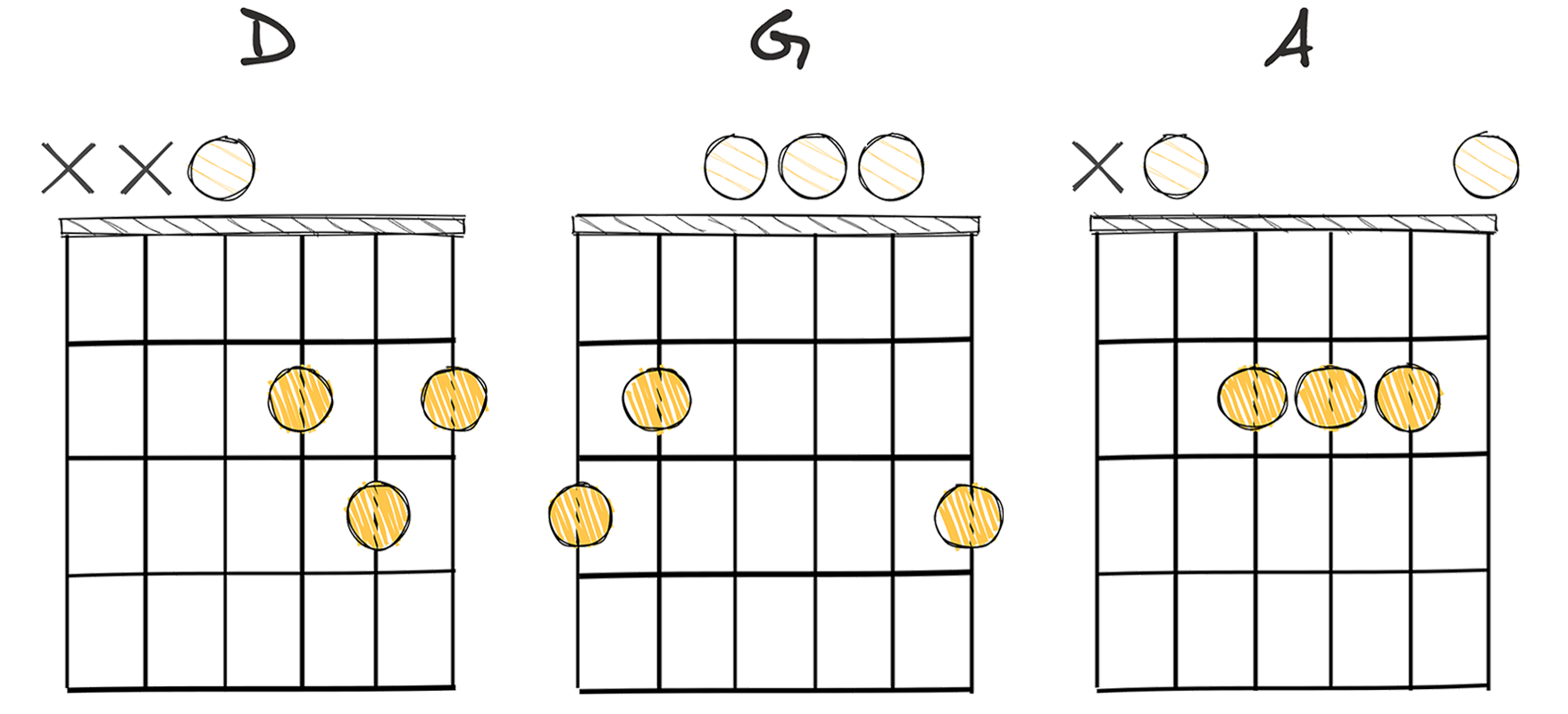
It’s hard to ignore the importance of chord progressions in creating a memorable melody, especially when it comes to popular genres like hip-hop.
The I-IV-V (1-4-5) chord progression, which translates to D major – G major – A major in the key of D, is one of the most widely used progressions in hip-hop music.
This progression, with its root note, fourth, and fifth chords, has been popularly employed by many talented hip-hop artists, crafting ear-catching melodies and memorable hooks.
Tracing back the lineage, the I-IV-V chord progression was adopted extensively in blues and rock-and-roll music before it found its way into hip-hop.
Indeed, this progression’s journey from blues to rock to hip-hop is testament to its versatility and enduring appeal.
The I-IV-V (1-4-5) is appreciated for its easy-to-play arrangement, comforting predictability, and potent evocativeness.
Moreover, when applied skillfully, the 1-4-5 offers a foundation that easily supports a variety of melodies and harmonies – a characteristic often leveraged by hip-hop artists.
Understanding the fundamental role of chord progressions like I-IV-V can help budding musicians navigate the world of hip-hop composition with greater ease and confidence.
Furthermore, the 1-4-5 progression has the unique capacity to lend a sense of balance and resolution to a piece by circling back to the root note.
This quality creates an enticingly looping essence that keeps listeners hooked, a sought-after feature in hip-hop tracks.
Though seemingly simple at first glance, the I-IV-V chord progression is an invaluable tool in a hip-hop artist’s repertoire, offering endless possibilities in creating enthralling sonic landscapes.
The usage of this progression in hip-hop underscores its potential to transcend genres and time periods, contributing to the formation of beautiful narratives told through music.
Recognizing and understanding the I-IV-V progression opens up a world of possibilities for musicians to explore, experiment, and eventually find their unique sound within the hip-hop genre.
Thus, the I-IV-V (1-4-5) chord progression, simple as it may seem, is undoubtedly a powerful tool in the creation of compelling hip-hop music.
ii-V-I (2-5-1)
The golden trio yielding mellifluous harmony in hip-hop chords.
The ii-V-I (2-5-1) progression is a staple in jazz music which has been widely adopted in hip-hop for its smooth, soulful transition and dynamic versatility. This sequences of chords provides a satisfying sense of resolution, making it an effective tool for songwriters and producers to craft compelling music.
- Difficulty: Intermediate
- Example: Dm7 – G7 – Cmaj7 (Key of C)
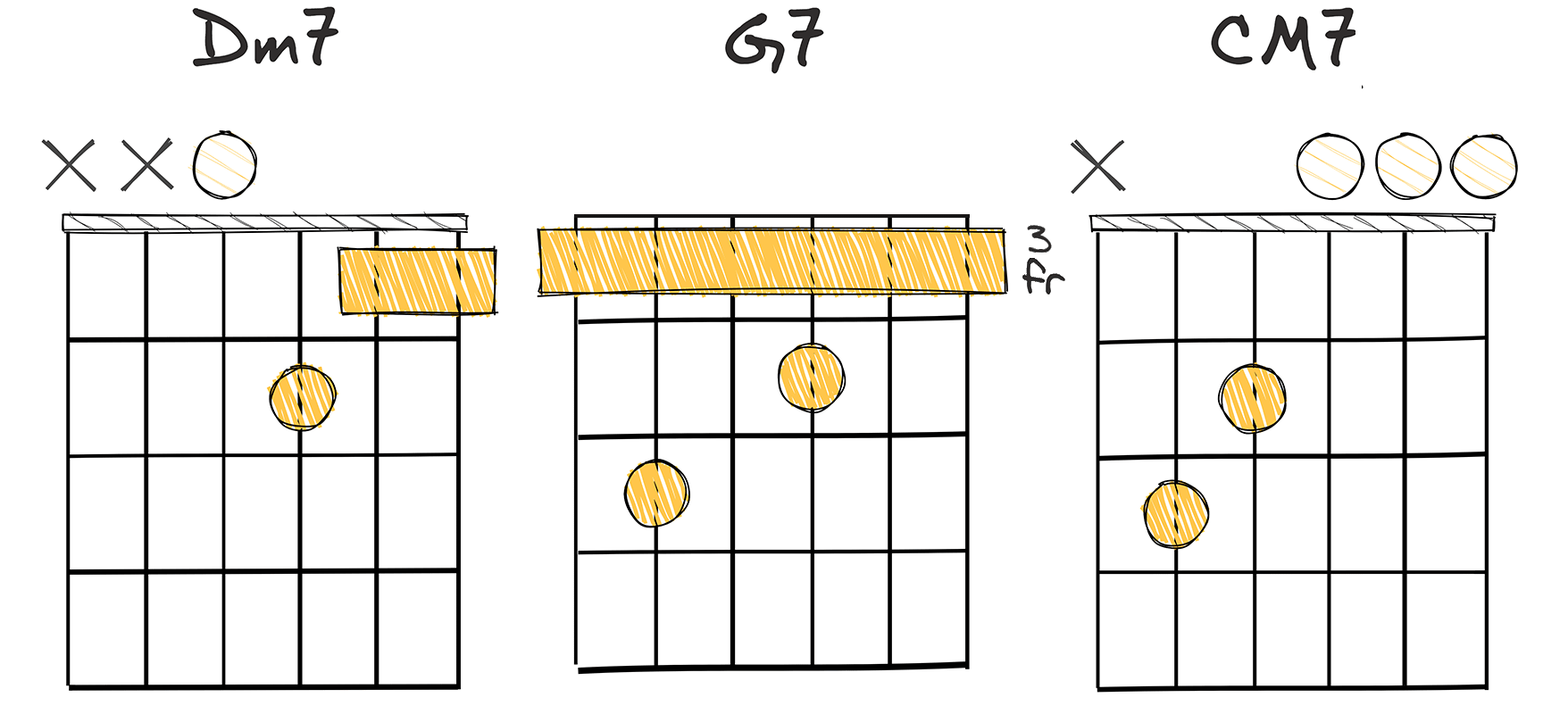
Hip-hop, with its diverse range of sub-genres and stylistic nuances, offers incredibly rich musical landscapes for beatsmiths to explore via chord progressions.
Although each genre within Hip-hop tends to have its ‘go-to’ chord progressions, the ii-V-I (2-5-1) holds special significance within the realm.
Recognized as a ‘jazz progression’, it has been gradually adopted to create more complex and textured beats in modern hip-hop.
The ii-V-I progression, represented in chordal form as Dmin7 – G7 – CMaj7 in the key of C, can be characterized as intermediate in its level of complexity.
This is primarily because it encompasses not only major and minor chords but also includes seventh chords, which add a layer of complexity.
When played, the ii-V-I creates a poignant sense of resolution, which is where much of its charm lies.
The ii-V-I’s history is firmly rooted in jazz, where it was heavily used in the bebop era between the 1940s and 60s.
Jazz musicians found that it provided an excellent framework within which to improvise, and its popularity swiftly grew.
As hip-hop began to emerge in the late ’70s and early ’80s, producers drew inspiration from a wide range of sources.
Jazz was particularly influential in hip-hop’s early days, playing a crucial role in shaping the burgeoning genre’s sound.
The ii-V-I progression, given its popularity in jazz, was ripe for exploitation in hip-hop.
By incorporating the ii-V-I progression into their beats, hip-hop producers managed to capture some of the lyricism, emotiveness, and fluidity of jazz, effectively transporting it into a new, more rhythmically focused context.
However, unlike in jazz, where the ii-V-I often forms the basis for complex improvisations, in hip-hop, it is frequently employed in a simplified, looped fashion.
This is no less compelling, though, as the tonal journey from the II to the V to the I chord creates an engaging musical narrative that the listener can follow with ease.
Of course, not all beats in hip-hop make use of the ii-V-I progression.
Still, when it is applied effectively, it contributes significantly to a beat’s melodic richness and complexity.
Thus, it’s clear that through its historical connection to jazz and its ability to offer complex, engaging harmonic narratives, the ii-V-I chord progression captures an integral essence of musicality within the broad and dynamic realm of hip-hop.
Continued exploration and creative application of this progression among beatmakers undoubtedly contribute to hip-hop’s musical innovation and evolution.
IV-IV-ii-V (4-4-2-5)
An unexpectedly smooth transition elevating the classic hip-hop ambiance.
This chord progression, IV-IV-ii-V, is a widely used sequence in the genre of hip-hop due to its smooth transition of chords and pleasing sonic qualities. It maintains a mellow and relaxed vibe, with the IV-IV offering a sense of stability, the ii adding tension, and the V preparing a rewarding resolution.
- Difficulty: Intermediate
- Example: F – F – Dm – G (Key of C Major)
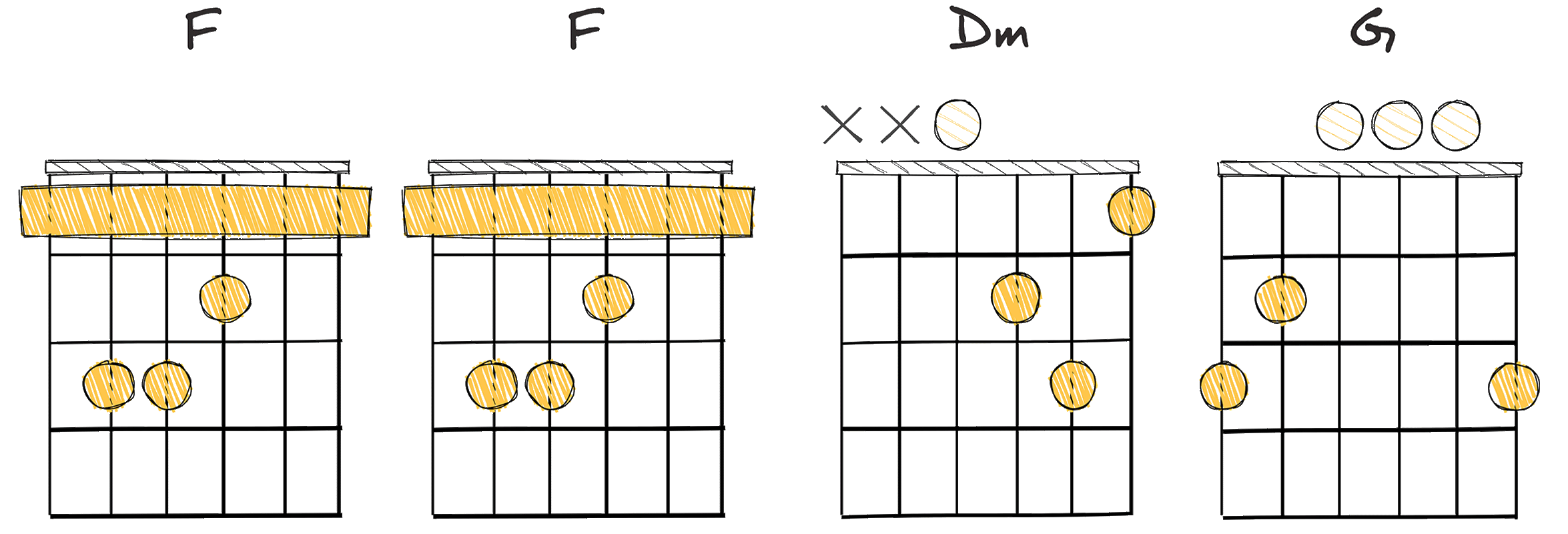
The IV-IV-ii-V (4-4-2-5) chord progression is an exquisite progression that finds its roots with deep ties in genres like hip-hop, R&B and even gospel.
This interesting combination of chords has a rich history and has proven itself to be a flexible staple in many songs over time.
The progression features a repeated IV chord which is then followed by the ii chord and rounds off with the V chord.
Its structure lends itself to instances of repetition that can create a spellbinding and echoing quality within a hip-hop track, which can be incredibly appealing.
The strategic placement of the ii chord in this progression often lowers the intensity of its preceding chords, providing a delicate balance in the song’s overall structure.
After this cool down, the V chord then re-ignites the energy, giving the progression a peculiar yet memorable ebb and flow.
This delicate balance of intensity and release adds a sense of depth and richness to the overall sound, making it an exciting choice for artists looking to keep listeners on their toes.
Holding an intermediate difficulty level, this chord progression requires a certain level of musical understanding and skill to implement effectively in a song.
Despite the challenge it presents, the IV-IV-ii-V progression has been aptly adopted and executed in a number of well-known songs in the hip-hop genre.
In the key of C Major, the chords in this progression would be displayed as F Major, F Major, G Minor, and C Major.
When arranged in this particular order, these chords create a soothing, cyclical rhythm that has become synonymous with a husky, melodic hip-hop sound.
The IV-IV-ii-V progression provides a refreshing twist on the traditional hip-hop sound, introducing an element of surprise that breaks the monotony associated with overused chord progressions.
This progression, despite its intermediate difficulty level, has a charming allure that captures the essence of good hip-hop music.
Its rich history, flexibility, and distinct character make it an excellent tool for artists looking to create engaging and melodious hip-hop tunes.
I-ii-V-I (1-2-5-1)
A classic progression delivering a timeless hip-hop vibe.
The I-ii-V-I chord progression marks a fundamental core in hip-hop music, characterized by its smooth, seamless transitions and resonating undertones. This progression, with its cyclical pattern and emphasis on harmony, creates a compelling depth and richness, making it a favorite among hip-hop artists for its ability to evoke strong emotions.
- Difficulty: Intermediate
- Example: C – Dm – G – C (Key of C)
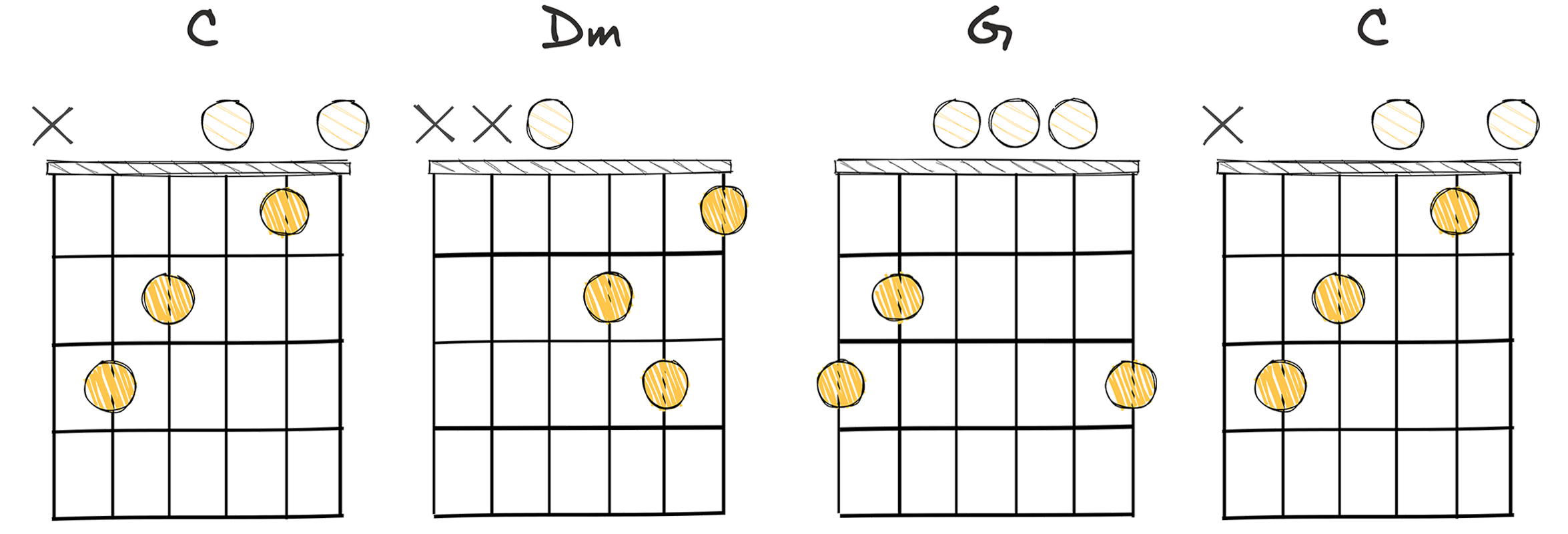
The I-ii-V-I chord progression, also known as the 1-2-5-1 sequence, constitutes one of the most common and intriguing chord progression patterns in Hip-hop music and across diverse music genres inherently.
These chords, when strung together, create an enthralling harmonic progression which is a defining characteristic of the hip-hop sound.
First and foremost, the I-ii-V-I progression is distinctly resonant and captivating due to the subtle tension and resolution inherent in the progression order.
To elaborate, the ‘I’ or tonic chord offers an unequivocal sense of home, a starting point.
On the other hand, the ‘ii’ or supertonic chord introduces a sense of tension leading up to the ‘V’ or dominant chord which elevates the tension.
Eventually, the transition back to the ‘I’ chord delivers a satisfying resolution bringing the cadence full circle.
As the listener, one gets to perceive this inherent tension and release throughout the progression, resulting in a fascinating sonic narrative that’s essential to the appeal of hip-hop music.
Furthermore, drawing from the history of the I-ii-V-I progression, it’s interesting to note that this pattern has proliferated in various forms of music over the centuries, including jazz, blues, pop and, needless to say, hip-hop.
While this progression is an indispensable asset in the repertoire of many successful hip-hop artists, it requires a moderate level of knowledge and skill on the part of the musician to be effectively employed.
Being an intermediate level chord progression, it implies that one needs to understand chord structures, chord transitions, and even a certain level of music theory to benefit most from this progression.
Despite the required learning curve, the pay-off in achieving a more textured, dynamic, and compelling musical piece is immensely rewarding.
Expressed in the Key of C, this progression translates to the chords C major – D minor – G major – C major, enhancing the song’s melodic dynamism while maintaining a smooth auditory journey for listeners.
Indeed, in the context of hip-hop music, the I-ii-V-I progression serves as an invaluable tool in the hands of innovative artists aiming to create emotionally reflective, rhythmically engaging and memorable musical moments.
Alongside the technical aspect, the I-ii-V-I progression also enables hip-hop artists to encapsulate their distinct musical voice effectively, contributing to their unique identity and style within the genre.
I-iii-IV-V (1-3-4-5)
A smooth, emotive flow defining the soul of hip-hop melodies.
The I-iii-IV-V progression in C major, represented by C-Em-F-G, exudes a smooth and reflective quality. Its transition from the major I chord to the minor iii adds a touch of melancholy, while the IV-V resolution brings a satisfying closure. This progression offers a balanced blend of emotion and harmony, making it appealing in various musical contexts..
- Difficulty: Easy
- Example: C – Em – F – G (Key of C)
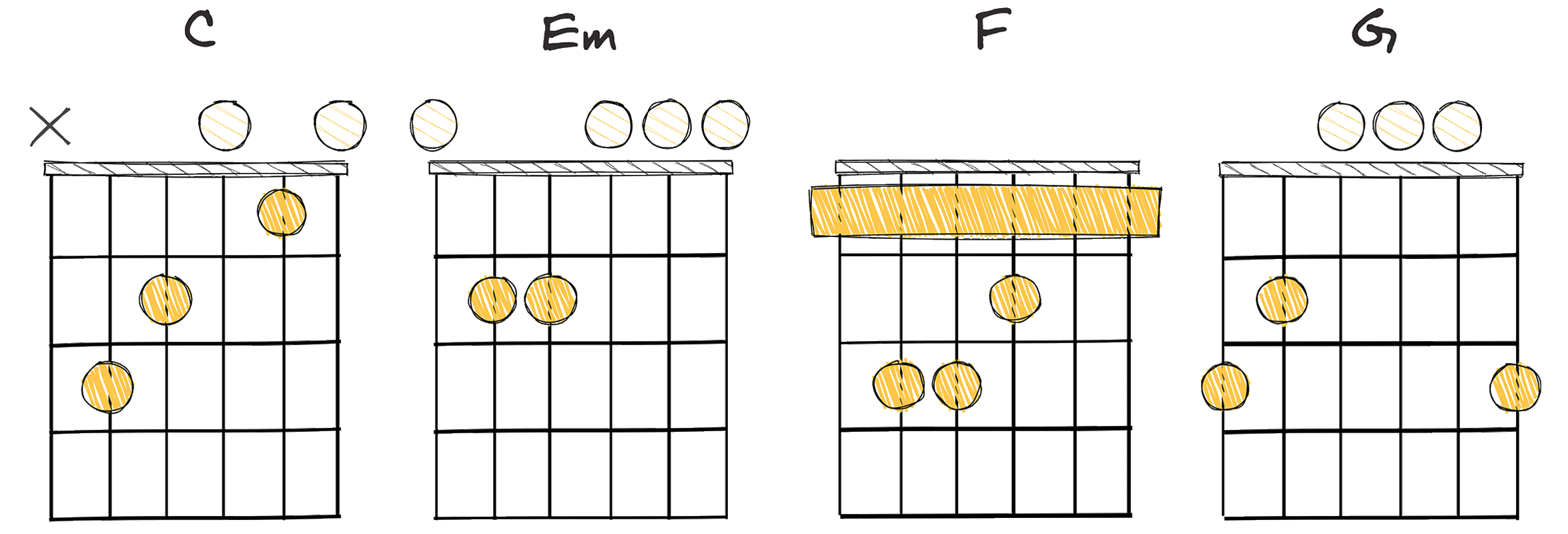
In the world of Hip-Hop, chord progressions play an integral role in shaping the sonic landscape that defines the genre.
Among these progressions is the often utilized I-iii-IV-V (1-3-4-5) progression; a grouping of chords that’s made appearances in countless Hip-Hop tracks over the years, from the underground to the airwaves.
Remarkably accessible, the I-iii-IV-V chord progression is familiar and easy to play.
And though its roots span far beyond the realm of Hip-Hop alone, its usage within the genre has become a symbolic thread weaving through the tapestry of its history.
In terms of musicality, the I-iii-IV-V progression offers a balance of harmonic interest and simplicity that’s appealing not just to the listener’s ear, but to the creator’s craft as well.
In this regard, its inherent ease of play and satisfying sonic resolution lends itself wonderfully to the beat-driven essence of Hip-Hop music.
Additionally, its flexible nature allows it to adapt seamlessly across a variety of different melodic and rhythmic contexts, further contributing to its widespread use.
The progression, represented in the key of C as C-Em-F-G, has the capability to convey a wide range of emotions depending on the surrounding musical context.
Be it the introspective ambience of a lo-fi track, or the uplifting choruses of pop-influenced Hip-Hop, this progression has consistently proven its worth within the genre’s sonic arsenal.
By understanding and utilizing this popular chord progression, artists and producers alike can access a wealth of harmonic potential and contribute to the ongoing evolution of Hip-Hop’s soundscape.
The I-iii-IV-V progression’s vast presence within Hip-Hop is a clear testament to its timeless appeal and a nod to its role in shaping the genre’s rich musical history.
With such a proven track record, the I-iii-IV-V progression continues to be a chord progression of choice for those in pursuit of creating Hip-Hop music that truly resonates.
I-V-vi-IV (1-5-6-4)
This classic progression delivers a soulful edge to hip-hop beats.
The I-V-vi-IV chord progression is a common musical sequence in hip-hop that offers a catchy, melodic base for diverse rhythms and flows. It is well-regarded for its versatility and pleasant sound, producing a harmonious balance of energy and emotional depth.
- Difficulty: Easy
- Example: F – C – Dm – Bb (Key of F)
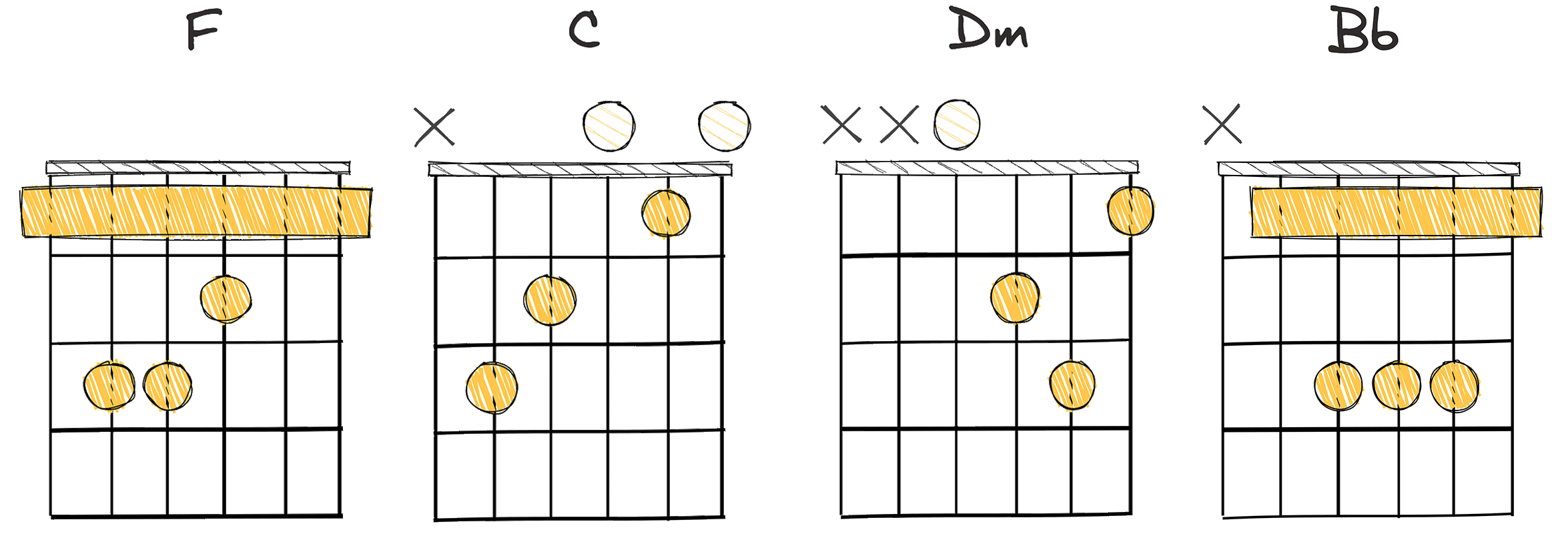
The I-V-vi-IV chord progression (1-5-6-4) is an undeniably popular sequence found in many genres of music, but its use in hip-hop is especially significant.
From hip-hop’s inception in the late 70s and early 80s, this chord progression has been a staple in the genre.
Its simplicity in structure does not compromise the profound emotional effects it can have on listeners.
The root chord (I), being the home base, conveys stability and familiarity; the dominant fifth (V), with its resolved tension, gives a triumphant and conclusive feeling.
However, introducing the relative minor sixth chord (vi) injects a sudden moodiness and introspectivity, and the subdominant fourth chord (IV) smoothly transitions back to the home base, creating a full musical phrase.
This rollercoaster of emotions encapsulates the essence of hip-hop, which often dwells on stories of struggle and triumph, sadness and joy, reality and dreams.
The ease of playing this progression is another reason for its widespread use in the hip-hop genre – a genre born from the creative genius of the urban youth who might not necessarily have formal musical training.
Accessibility and relatability are just as pivotal to hip-hop music as the beats themselves.
The I-V-vi-IV chord progression, with its easy-to-play structure and emotionally rich sounds, embodies hip-hop’s heart and soul.
Despite its simplicity, this chord progression offers musicians endless explorations of melody, rhythm, and lyrical content.
Its wide usage across many successful and iconic hip-hop songs bears testament to its influence and importance in defining the genre’s sound and character.
I-IV-I-vi (1-4-1-6)
The I-IV-I-vi chord progression is a versatile sequence embraced in various genres, including hip hop.
The I-IV-I-vi (1-4-1-6) chord progression is a musically rich sequence that transcends genres. Its simple structure allows for both emotional depth and innovative experimentation, making it a go-to for many artists across styles like hip hop and pop. This timeless progression serves as a harmonic bridge, connecting different musical landscapes and resonating with listeners universally.
- Difficulty: Intermediate
- Example: G – C – G – Em (Key of G)
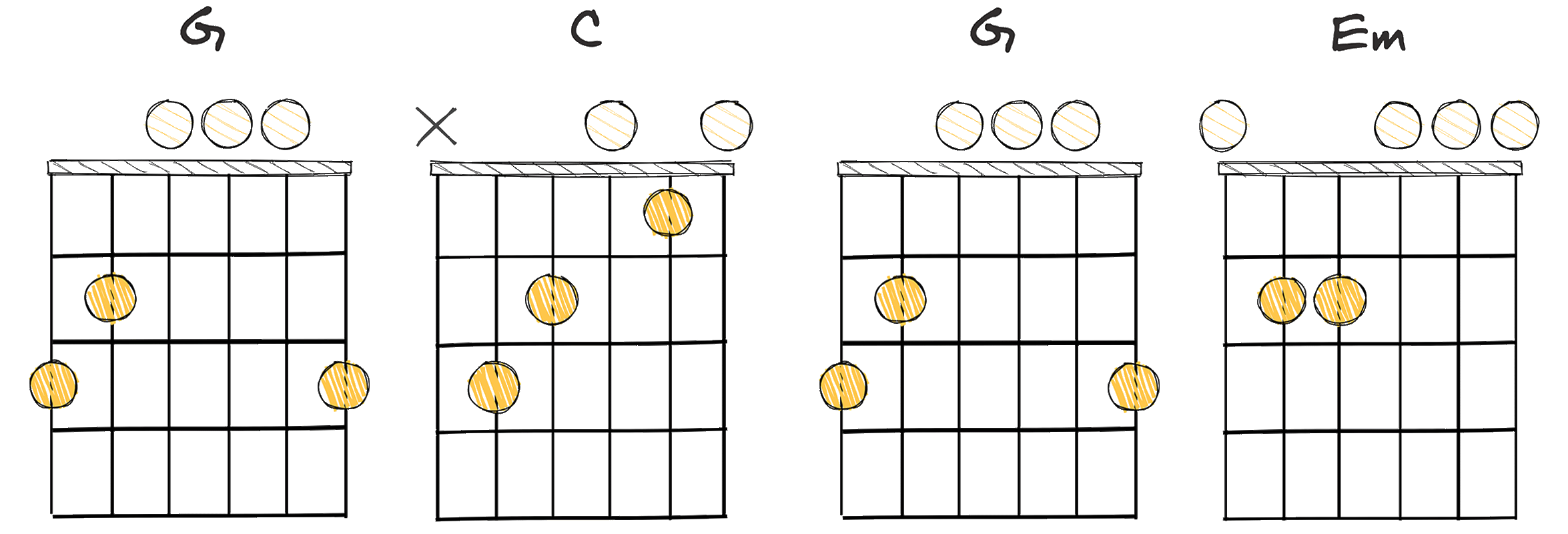
The I-IV-I-vi chord progression is a harmonic sequence that resonates with a broad musical palette, holding an esteemed place in the lexicon of musical history.
Its simplicity belies a depth and flexibility that makes it a favorite among composers and songwriters across many styles.
In the realm of hip hop, a genre that often thrives on innovation and rhythmic mastery, this progression finds a unique application.
Here, it’s used as an underpinning structure, providing a canvas on which intricate beats and lyrical complexities can be painted.
The repetitiveness of the 1-4-1-6 progression offers a comforting predictability, allowing producers and artists to experiment with rhythm, melody, and texture without losing the audience’s connection to the music.
It’s a progression that can evoke a sense of nostalgia, often utilized in songs that speak of love, loss, or reflection.
Its universal appeal lies in its ability to resonate with the human experience, regardless of musical context.
The I-IV-I-vi has the uncanny ability to be both foreground and background, leading the melody in some pieces while subtly supporting others.
Musically speaking, this progression’s sonic landscape is like a well-worn path through a lush forest.
The I and IV chords form the sturdy ground beneath your feet, while the vi chord is like a turn in the path, revealing a hidden vista or a shadowed glen.
It’s a progression that invites exploration and interpretation, allowing musicians to infuse their unique voice into a shared harmonic language.
Moreover, the 1-4-1-6’s adaptability is a testament to the power of music to transcend boundaries.
I-IV-vi-iii (1-4-6-3)
This musical pattern creates a reflective mood, weaving warmth and introspection..
The chord progression C – F – Am – Em (I – IV – vi – iii) in C major is a rich blend of warmth and introspection. Moving from major to minor chords, it creates a balanced, reflective mood, suitable for storytelling in various musical genres.
- Difficulty: Easy
- Example: C – F – Am – Em (Key of C)
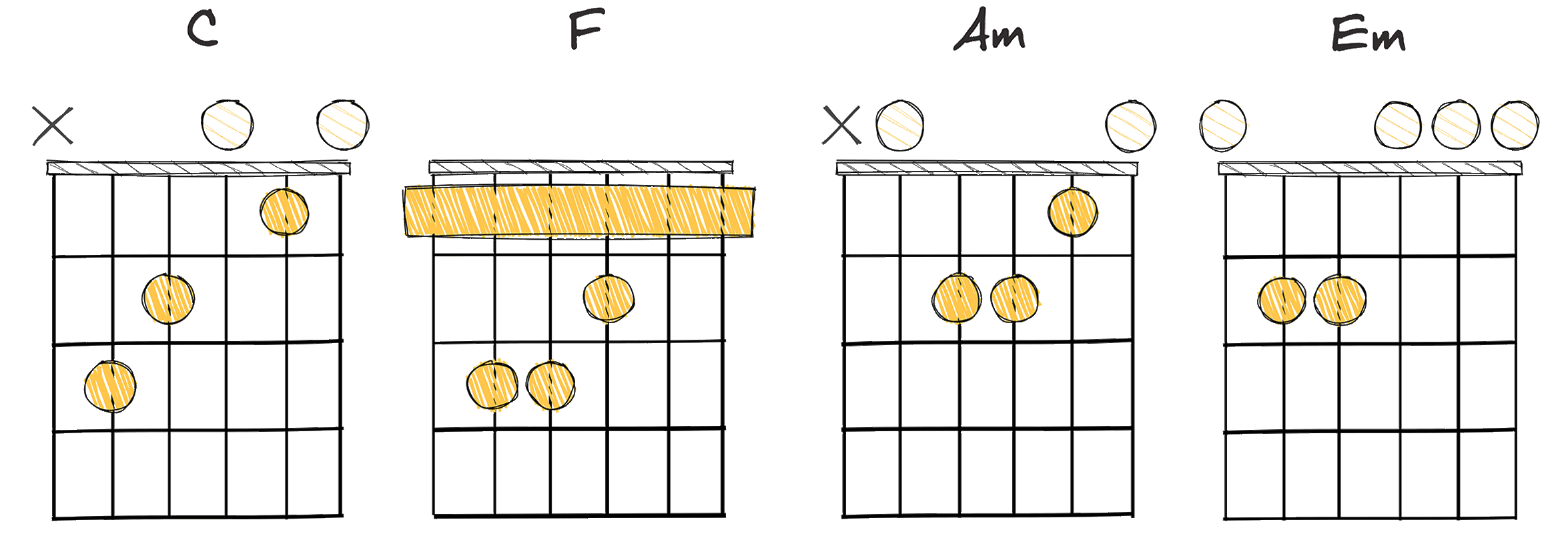
If we delve into the focus of the 8th section, I-IV-vi-iii (1-4-6-3), we can see a chord progression that strikes a balanced and pleasing mix of predictability and surprise, which is one of the main elements that make Hip-Hop music so distinctive and loved.
This specific chord progression, comprised of the chords C – F – Am – Em (in the Key of C), makes it easy for producers of all levels to create diverse music because it presents a solid ground from which to build upon.
Known to be easy to play, this progression contributes significantly to the overall structure of a Hip-Hop track, providing it with a certain depth and rhythmic complexity that resonates with listeners in a way that is quintessentially Hip-Hop.
These chords do not just make the progression easy to play but also grant it a versatility that allows producers to experiment with various tempos, beats, and melodies.
The ability to experiment with various elements of music around these chords is a testament to their flexibility.
Moreover, the combination of a major chord followed by a minor chord helps in creating an intriguing sonic contrast, adding a subtle touch of variation into the mix.
Tracing back to its roots, this four-chord progression has a rich and deep history in the field of music.
It can be found in some of the most iconic Hip-Hop tracks, transforming and evolving over time to adapt to the changing trends and styles within the genre.
Moreover, the harmonic progression plays an integral role in the overall musical context, contributing to the unique ‘feel’ and sound that is so inherent to the genre.
It is indisputable that this progression, apart from being easy to play, also offers an expansive range for creativity and experimentation.
This not only allows novice producers a chance to break into the genre, but also provides established artists with a solid foundation upon which they can enhance their music with their unique stylization.
Lastly, the progression’s inherent versatility makes it a suitable choice for a wide variety of Hip-Hop sub-genres, reinforcing its significance across the entire genre.
vi-V-IV-III (6-5-4-3)
A melancholic yet uplifting journey, favored in reflective hip-hop ballads.
This progression, vi-V-IV-III, is a popular choice within the genre of hip-hop, producing a distinctively smooth, rhythmic flow that lends itself well to rap verses and hooks. Characterized by its unique voice-leading and rhythmic variance, it provides a versatile foundation for a variety of musical expressions within each chord switch, making it a staple for many creative processes.
- Difficulty: Intermediate
- Example: Am – G – F – E (Key of C)
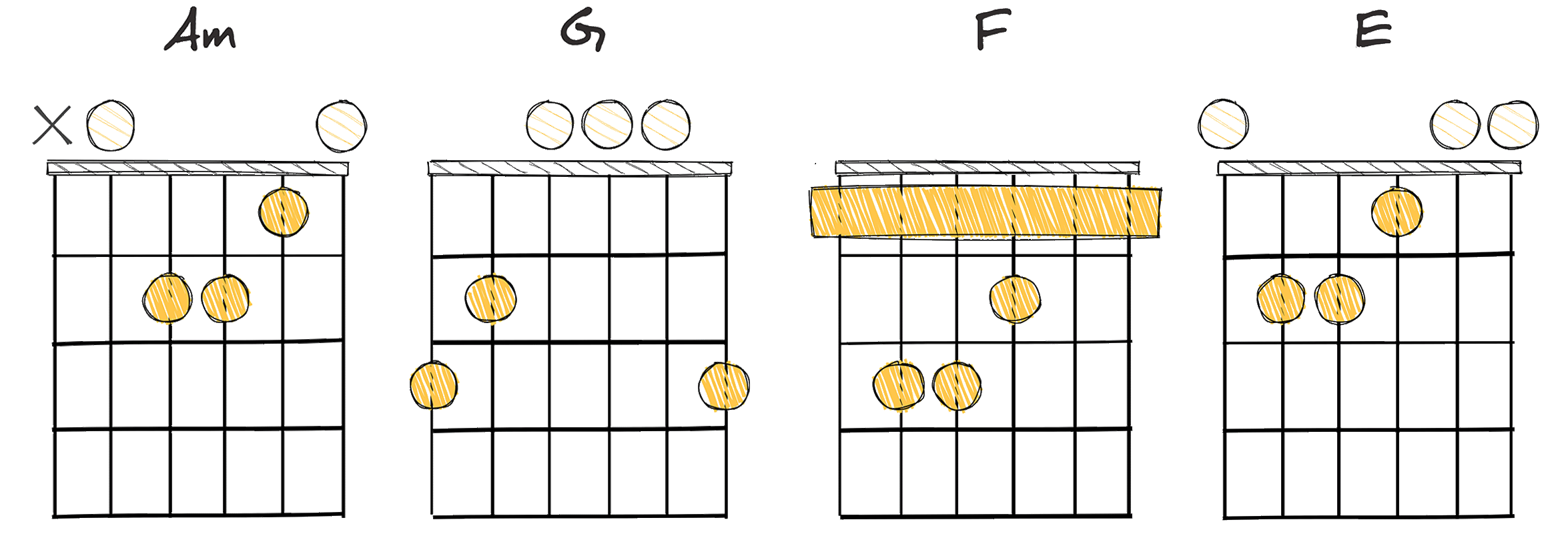
When it comes to chord progressions that resonate well within the hip-hop genre, the vi-V-IV-III progression, equivalent to 6-5-4-3, proves to offer great versatility and a unique auditory character.
This chord progression, predominantly known for its rich, intriguing, and compelling harmonies, is often applied in intermediate hip-hop compositions.
The vi-V-IV-III progression is not the type that immediately comes to mind when one thinks of common chord progressions, but it has made remarkable contributions to hip-hop music.
Based on its structure, the progression combines contrasting tonal elements, resulting in a distinctive flavor that is sure to captivate listeners.
Artists who can successfully wield this chord progression in their compositions often find that it can enhance the emotional evocativeness of their music, setting their work apart from the crowd.
The vi-V-IV-III progression is generally harmonically flexible, allowing a song to wander through various emotional landscapes with a unique blend of tension and resolution.
The progression, although requiring a bit more skill to master, is a favorite for many musicians due to the flexibility it offers, allowing for innovative and creativeness in musical composition.
Historically, though not as frequently utilized as other chord progressions, this one has made its way into several timeless hip-hop tracks, proving its efficacy and appeal.
Thus, the progression’s dexterity and unique tonal structure make it a powerful tool in the hands of any innovative hip-hop artist.
Despite being slightly complex to master, the progression’s ability to add depth and mood to a song is simply unmatched.
The use of this progression, therefore, is one of the ways that an artist can make their mark, exploring new musical terrains while still maintaining their roots in the hip-hop genre.
Hence, the vi-V-IV-III, while not the most common, has solidly earned a place in the toolkit of chord progressions for creating great-sounding hip-hop music.
The progression’s rich harmonic structure and the mood it brings to compositions make it a wonderful choice for artists keen on pushing the boundaries of hip-hop music.
Therefore, an understanding and appreciation of this progression are fundamental for any hip-hop artist striving to expand their musical horizons and create engaging, compelling compositions.
I-IV-V-IV (1-4-5-4)
This progression offers a soulful backbone to hip-hop creations.
This chord progression follows a cycle from the tonic (I), to subdominant (IV), dominant (V), and back to subdominant (IV), creating a pleasing harmonic rhythm. In the context of hip-hop music, it lends itself to a wide range of moods and tones, making it a versatile choice for producers and composers.
- Difficulty: Easy
- Example: C – F – G – F (Key of C)
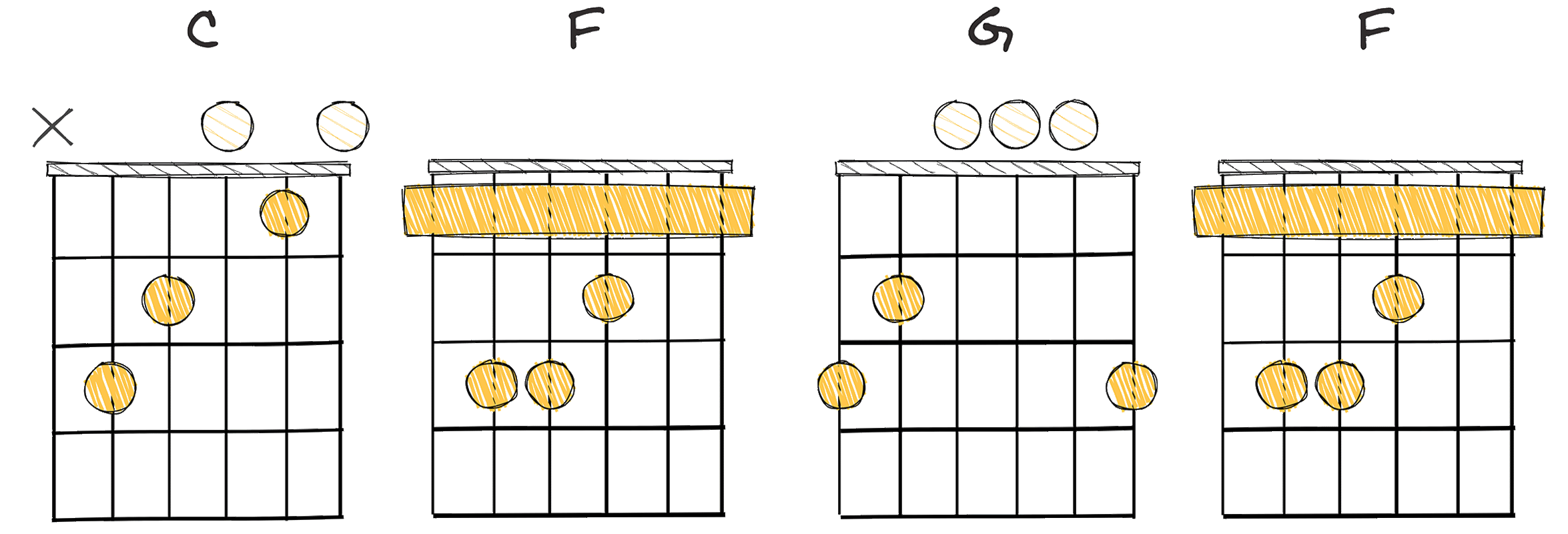
Hip-Hop is an eclectic genre with its sound rooted in various chords that artists utilize to bring their unique rhythm and storytelling to life.
The chord progression I-IV-V-IV (1-4-5-4) is also a popularly employed arrangement in hip-hop understanding its effect is quite essential to attaining a deeper appreciation of the genre and creating more diverse and impressive tunes.
Its foundation on the first, fourth, and fifth notes of the diatonic scale – in this case, the C Major, F Major, G Major, and F Major chords (Key of C) – creates a combination of sounds that is both compelling and upbeat.
This Chord progression is easy to play and offers a sonic depth that instantly connects with listeners across different ages and backgrounds.
The simplicity of this arrangement makes it a favourite amongst budding hip-hop artists as it aids their exploration of sounds, harmonies, and musical expressions.
Furthermore, its uplifting rhythm makes it a perfect choice for energetic and uplifting songs.
Historically, this particular I-IV-V-IV arrangement has roots firmly set in traditional blues and rock music.
However, with the advent of hip-hop and its daring exploration of new and old sounds, this chord progression found a new home.
It has been effectively employed by various phenomenal hip-hop artists across different eras to create songs that have stood the test of time.
It should be noted that while the chords themselves are simple, it’s the combination of their order and timing with the lyrics which adds to the song’s profoundness.
There is no doubt that the I-IV-V-IV chord progression holds a meaningful place in hip-hop music.
Its ability to evolve with the genre and mold into any mood is testament to its versatility and necessity in the industry.
Moving forward, artists who successfully harness its potential stand a chance at creating more compelling, timeless tracks.
Indeed, the I-IV-V-IV progression is more than just chords; it is a key ingredient that turns mere tunes into an emotional journey.
ii-IV-I (2-4-1)
Classic progression imbuing hip-hop tracks with soulful, laid-back vibes.
This 2-4-1 chord progression, commonly encountered in hip-hop, creates a smooth, relaxed vibe and has a compelling resonance. The progression moves from a supertonic or ii chord, to a subdominant or IV chord, and finally resolves to the tonic or I chord, establishing a comfortable and pleasing tonal variety.
- Difficulty: Intermediate
- Example: Gm – Bb – F (Key of F)
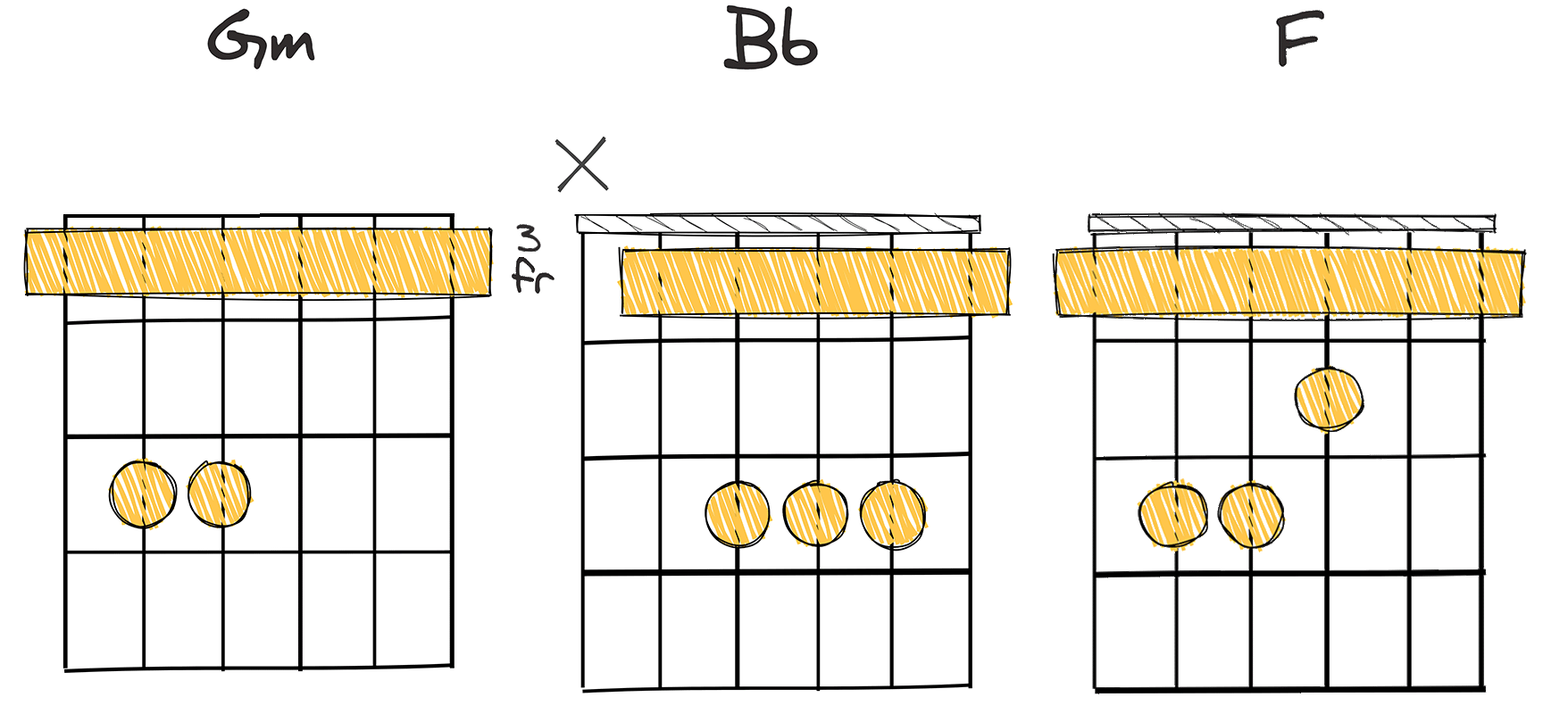
This progression is known for its dramatic, soulful tone, and is often used to create a certain mystique or tension in the song.
With its roots stemming from classical music, the ii-IV-I progression has been adapted and reinterpreted across multiple genres before finding its place in hip-hop.
The sequence begins on the G minor chord (ii), which due to its minor quality, can bring a certain sense of melancholy to the music.
The G minor then beautifully transitions into the Bb (IV) , a major chord that perfectly contrasts the preceding minor tone.
“The natural shift from G minor to Bb Major is what gives this progression its notable character, easily recognizable in numerous hip-hop tracks.”
Following this, the progression closes on the F Major chord (I).
This chord feels like a resolution, tying the progression together in a satisfying conclusion, even though the music itself may continue to other chords or repetitions of the same progression.
In hip-hop production, the 2-4-1 progression is often manipulated and distorted with electronic software to create a more modern, synth-like sound.
Even though the ii-IV-I progression might seem intermediate to play initially, its complexity lies in the emotional depth it can communicate when used effectively.
The use of this progression has evolved over time, and it’s evident that the 2-4-1 progression has made its way from the concert halls of classical symphonies to the gritty, raw sound of hip-hop beats.
The recurring use of this chord progression underlines its timeless appeal and potential for creating impactful songs in hip-hop music.
Future uses of this progression will continue to evolve, thereby wielding a powerful influence on hip-hop music.
Further exploration into this classic progression will undoubtedly unlock even more creative possibilities for hip-hop artists and producers alike.
vi-ii-V-I (6-2-5-1)
A classic jazz-influenced progression, injecting sophistication into hip-hop.
The vi-ii-V-I (6-2-5-1) chord progression is a revered sequence in hip-hop music, widely recognized for its harmonious and pleasing resonance. The progression works seamlessly, creating an engaging musical framework due to its descending fifths movement – generating a satisfying sense of resolution when reaching the ‘I’ chord.
- Difficulty: Intermediate
- Example: Am – Dm – G – C (Key of C)
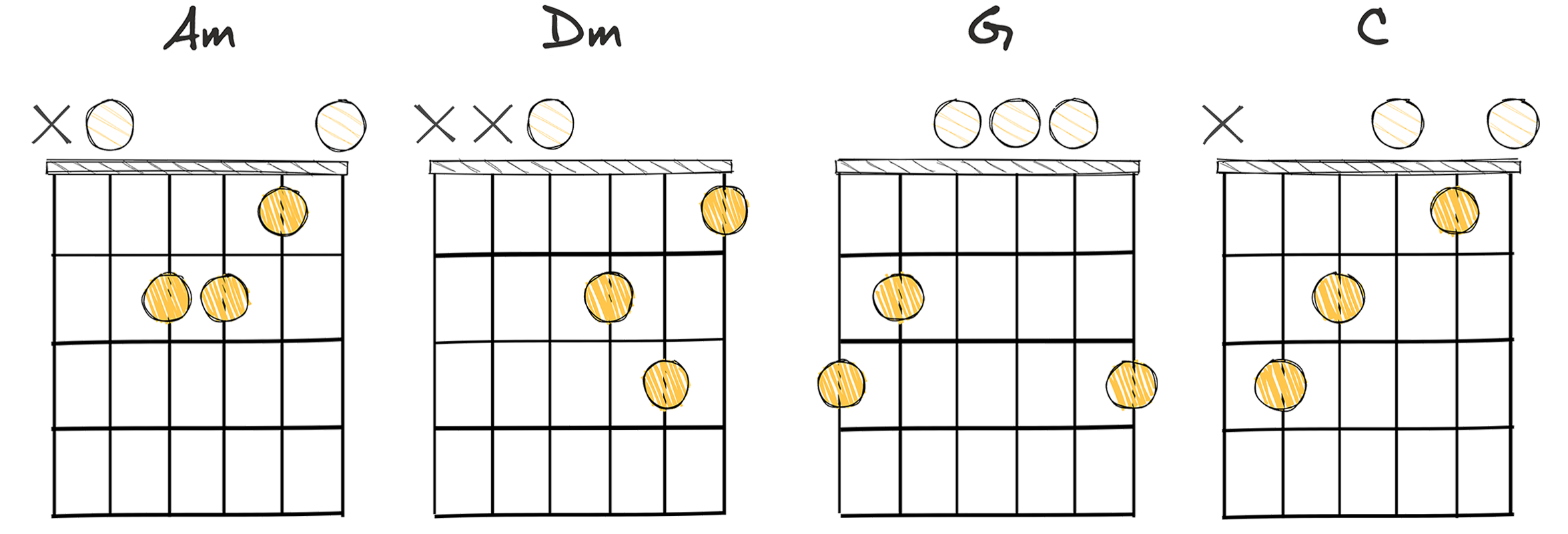
When discussing hip-hop chord progressions that truly resonate with listeners, our attention is drawn to vi-ii-V-I (6-2-5-1).
This chord progression, also known as the 1625 progression, has an important place in music theory and is utilized quite frequently in various genres, including hip-hop.
Because of its consistent pattern of descending fifths, it makes for a very compelling and rhythmical progression.
This progression, often found in the key of C as Am – Dm – G – C, creates a smooth, natural flow between chords, something highly favored in hip-hop music.
Notably, these four chords of the 1625 progression are described as ‘intermediate’ to play.
Being labeled ‘intermediate’ generally means that, while they are not the simplest chords, they aren’t excessively complex either; thus, they provide room for an artist to flex their creativity and skill.
Moreover, mastering this chord progression opens the door to a broader range of musical expression and innovation within the hip-hop genre.
Historically, the 1625 chord progression has roots in classical music and jazz before becoming a prominent figure in popular music genres such as hip-hop.
In fact, this progression can be found in a number of celebrated hip-hop tracks.
The progression’s pleasing aural qualities contribute significantly to the song’s overall appeal, helping it to resonate with listeners.
In hip-hop, the 1625 progression is often used to evoke a sense of nostalgia or melancholy, typically inducing a reflective and heartfelt tone.
The vi-ii-V-I progression’s versatility and dynamic potential are part of what makes it so popular in hip-hop music.
As we delve deeper into hip-hop chord progressions, it is clear that the 1625 progression holds a significant place within this genre due to its sonic appeal and historical relevance.
In an industry that thrives on innovation and authenticity, it’s no surprise that the vi-ii-V-I is highly sought after.
It’s safe to assert that this progression plays a significant role in shaping the distinctive soundscape of the hip-hop genre.
Exploring the 1625 chord progression allows us to understand not only its technical specifics, but also how it is leveraged to enhance the emotional depth and musical texture in hip-hop.
ii-iii-IV (2-3-4)
A harmonic journey from tension to resolution in hip-hop music.
The ii-iii-IV chord progression is a simple, yet catchy, progression often used in hip-hop music to create a smooth and laidback sound. It creates a melancholic tone while still providing the upbeat rhythm needed in the genre.
- Difficulty: Intermediate
- Example: Dm – Em – F (Key of C)
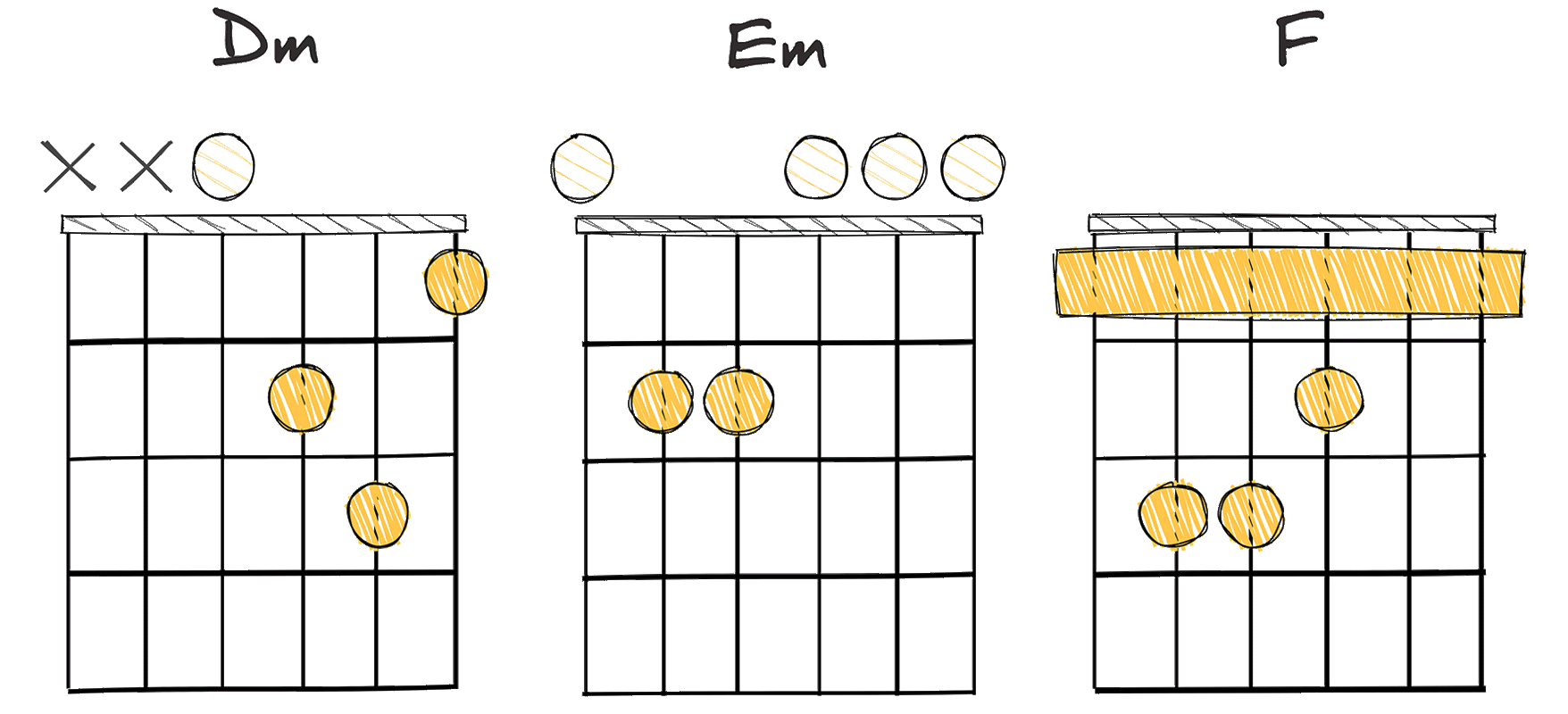
In the vast array of hip-hop chord progressions, one particularly noteworthy progression stands out, namely ii-iii-IV (2-3-4), or in the key of C: Dm – Em – F.
Historically, this progression was not very common in hip-hop; however, over the years, it has become increasingly popular in the genre.
One can credit this shift in popularity mainly due to innovative artists who are always looking for fresh ways to shake up the genre and further expand its boundaries.
Not surprisingly, it’s the artists who aren’t afraid to experiment with non-traditional sounds and musical elements that typically push these boundaries.
The ii-iii-IV (2-3-4) chord progression, despite its relatively recent adoption in hip-hop, has now become a staple of the genre, appreciated for its unique vibe.
As the quoted sentence stated, the 2-3-4 progression is now a staple in hip-hop, broadly used for its unique sonic flavor and its capacity to create an emotional impact on the listener.
When we dissect this progression, we see that it consists of three intermediate difficulty level chords.
Playing these chords assumes some basic knowledge of music theory and keyboard skills, which most hip-hop producers and beatmakers would have.
The ii-iii-IV (2-3-4) chord progression, despite its intermediate level difficulty, is a powerful tool in the hip-hop producer’s arsenal.
It can be used to create a wide variety of moods and vibes, and, as demonstrated by songs like “London Bridge,” it can help make a hip-hop song instantly catchy and memorable.
However, like all other musical tools and techniques, its effectiveness ultimately comes down to the skill and creativity of the musician or producer using it.
I-IV-ii-V (1-4-2-5)
A smooth, classic flow creating staple rhythms in hip-hop music.
The I-IV-ii-V chord progression is a classic sequence used frequently in hip-hop music, well-known for its pleasant and satisfying harmonic movement. This progression is built on the first, fourth, second, and fifth chords of the scale, offering a smooth, flowing progression that features tonal variety, making it a popular choice for creating catchy, memorable beats.
- Difficulty: Intermediate
- Example: C – F – Dm – G (Key of C Major)
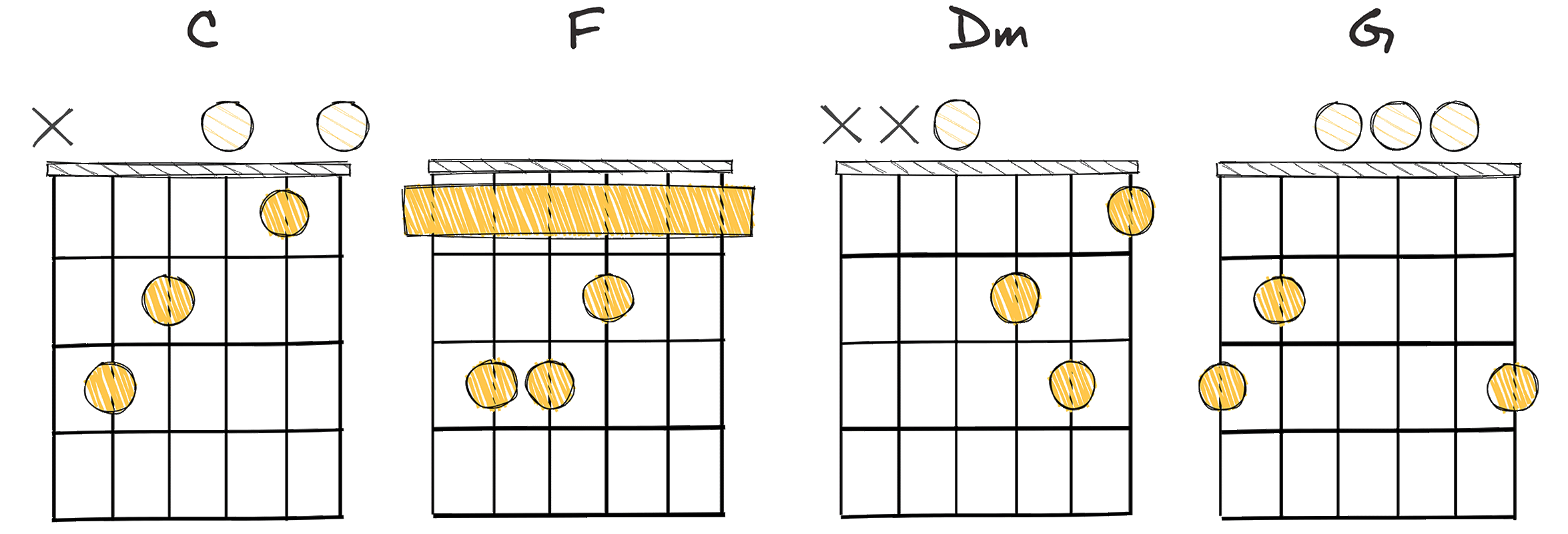
The I-IV-ii-V is one of the many diverse chord progressions utilized in hip-hop music, an aspect that contributes significantly to the melodic richness of this genre.
Known to exhibit intermediate complexity, the I-IV-ii-V chord progression demands a degree of understanding and expertise in music theory.
Going back to its origins, this progression is rooted in the traditions of jazz, a genre that has always challenged notions of harmony and rhythm.
The jazz influence over hip-hop is distinct and profound, and the I-IV-ii-V progression is a testament to this intimate relationship.
When we analyze this progression within the framework of the key of C Major, we are dealing with the following chords: C Major (I), F Major (IV), D Minor (ii), and G Major (V).
Interestingly, this opens up an arena of melodic and rhythmic possibilities that keep the listener engaged.
Defined by its unique blend of major and minor chords, the I-IV-ii-V progression creates a balance of euphony and dissonance, a characteristic feature intrinsically linked to the stylistic traditions of hip-hop.
Prolific artists often leverage these tonal shifts, using them to heighten the emotional impact of their lyrical content.
In hip-hop, where words often bear a weighty message, supplementing lyricism with the compelling harmony of the I-IV-ii-V progression can elevate the overall composition.
They complement and potentially amplify the lyrical narrative, thereby providing a richer immersive experience for the listener.
Furthermore, the intermediate complexity of this progression opens up spaces for interesting rhythmic developments.
The utilization of syncopation, off-beat phrasing, and intricate rhythmic patterns are all engaging possibilities offered by this progression.
In genre-blurring hip-hop tracks, the distinctive I-IV-ii-V progression often provides the robust harmonic infrastructure necessary to accommodate complex rhythmic structures.
This example underscores the progression’s versatility and adaptability in capturing the aesthetic of hip-hop in its multifaceted essence.
Whether it’s blending different genres or amplifying lyrical depth, I-IV-ii-V continues to redefine and enrich the hip-hop soundscape.
IV-I-V (4-1-5)
A foundational sequence offering captivating tension and resolution in Hip-Hop.
The IV-I-V progression, commonly known as the Four-One-Five progression, is a cornerstone in hip-hop music, marked by its rhythmic variation and harmonic simplicity. Apart from its appealing sonic qualities, it provides an excellent framework for composers to innovate, thus being integral to creating hip-hop tracks that resonate well with listeners.
- Difficulty: Easy
- Example: F – C – G (Key of C)
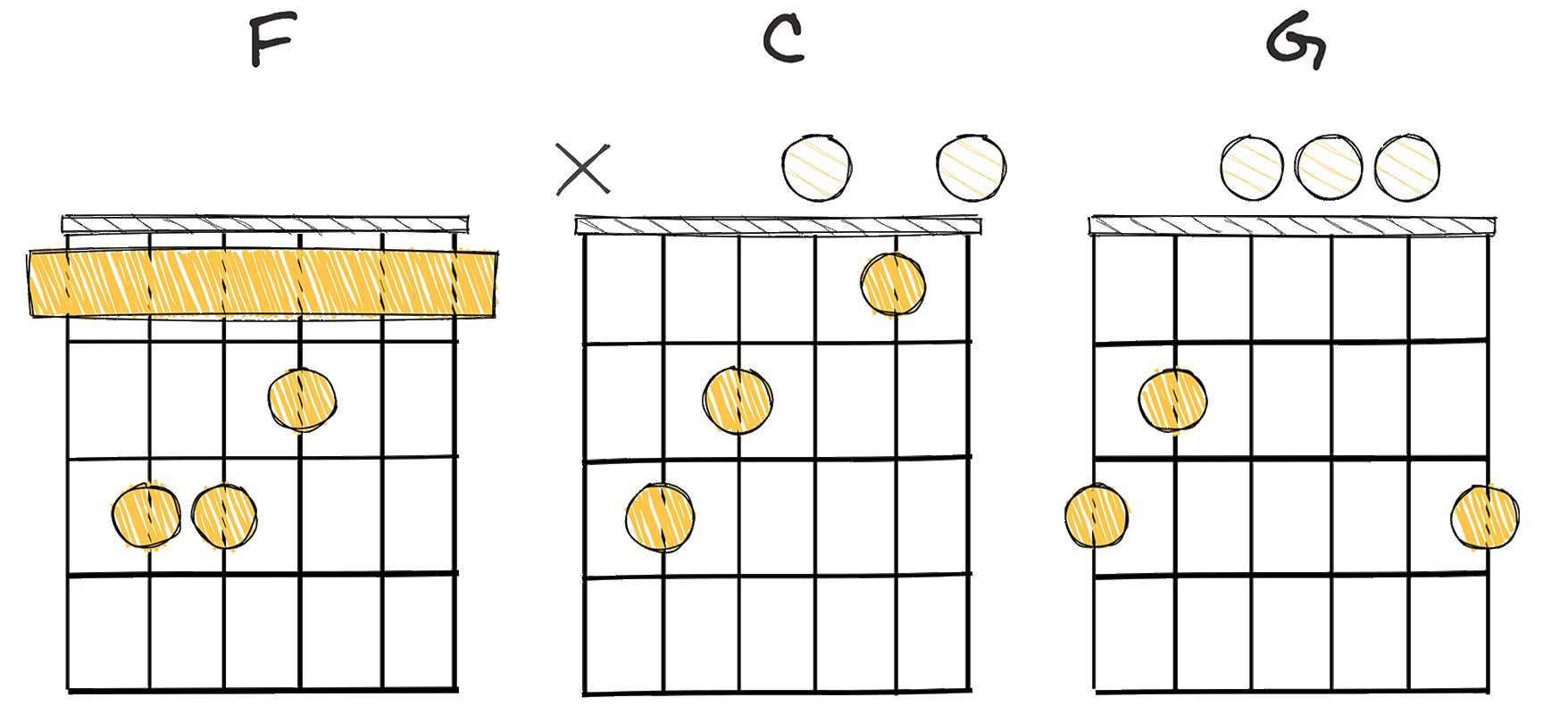
Often overlooked, this chord progression has a rich history that contributes to its unique sound in hip-hop tunes.
Originating from classical music, the IV-I-V progression is considered one of the most fundamental foundations upon which many songs are built.
It was subsequently adopted by various other genres, from blues to rock and pop, before finding its place in the heart of hip-hop music.
Because of its simplicity, the IV-I-V chord progression is incredibly versatile and easy to incorporate into various tunes.
This versatility means it can be manipulated to suit different styles and moods within the hip-hop genre, making it a favourite among many hip-hop artists and producers.
Furthermore, this chord progression is easy to play, offering beginners a great starting point in their musical journey.
Many hit songs in hip-hop have used the IV-I-V progression.
While the IV-I-V progression may be simple in structure, its versatility in creating distinctive melodies within hip-hop music should not be underestimated.
By manipulating the tempo, rhythm, or even the key signature, the IV-I-V progression can facilitate a wide range of musical expressions.
It’s this very openness to experimentation that makes the IV-I-V progression continue to be a staple in modern hip-hop music production.
I-IV-V-vi (1-4-5-6)
A melodic backbone for unforgettable hip-hop anthems.
This I-IV-V-vi chord progression is a classic and populist sequence dominant in hip-hop music, providing a foundation of stability and familiarity while leaving room for creativity. Its circular progression and resolution on the relative minor (vi) makes it inherently satisfying, imbuing a sense of anticipated return, creating a dynamic tension that pairs well with the rhythmic element in hip-hop.
- Difficulty: Easy
- Example: C – F – G – Am (Key of C)
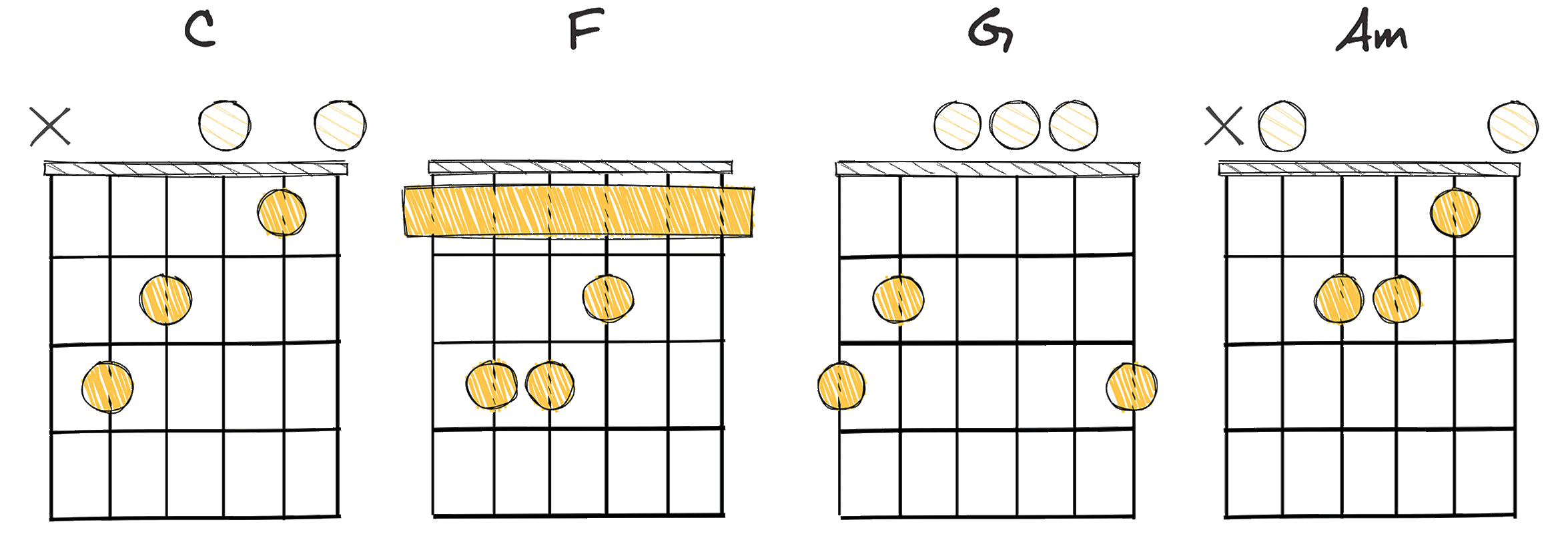
Hip-Hop Chord Progressions have grown in popularity, and the I-IV-V-vi progression comes as one of the most recognizable and beloved among the practitioners and consumers of this genre.
Following the C Major – F Major – G Major – A Minor sequence, the I-IV-V-vi chord progression is a common and integral element of the hip-hop music scene.
That is prominently because it is easy to play, making it an excellent choice for beginners in the music production industry.
C Major, being the ‘I’ chord, has an upbeat, bright, and positive sound that makes up for many feel-good hip hop tracks.
Then we have the F Major or the ‘IV’ chord, which changes the tone, adding depth and grounding the music.
This grounding effect introduces a contrast, which is necessary to avoid monotony and keep the listeners captivated.
The interesting switch happening with the transition from ‘I’ to ‘IV’ keeps the progression dynamic, further narrating the story of the piece.
Next in line, the ‘V’ chord, G Major steps in, offering an excellent rising tension to the song.
This rising tension provided by the G Major chord gives a sense of anticipation, holding the listener on the edge of their seat, waiting for the resolve.
It maintains a certain harmony and coherence within the musical piece, connecting all elements together.
The final chord in the series, the A minor or ‘vi’ chord, offers a satisfying resolution.
It brings a melancholic tone, playing a significant role in creating the common emotional intensity found in hip hop music.
These four chords, I-IV-V-vi, when used cleverly, can result in pieces with incredible emotional depth and musical richness.
Indeed, the simplicity of this progression makes it a favorite pick among hip-hop artists, resulting in catchy and memorable tunes.
Looking at the history, the I-IV-V-vi hip-hop chord progression, like many other chord progressions, has its roots in jazz and blues, which influence the hip-hop genre a lot.
But no matter where it started, it’s undeniable that the I-IV-V-vi progression adds a distinct flavor to the world of hip-hop music.
ii-vi-V (2-6-5)
This ii-vi-V progression creates groovy, catchy hooks in hip-hop.
The ii-vi-V chord progression, also known as 2-6-5, is a common sequence in hip-hop music that typically creates a smooth, flowing sound. This progression allows for great versatility, providing a base for artists to layer melodies and harmonies, establishing an appealing musical framework.
- Difficulty: Easy
- Example: Em – Bm – A (Key of D Major)
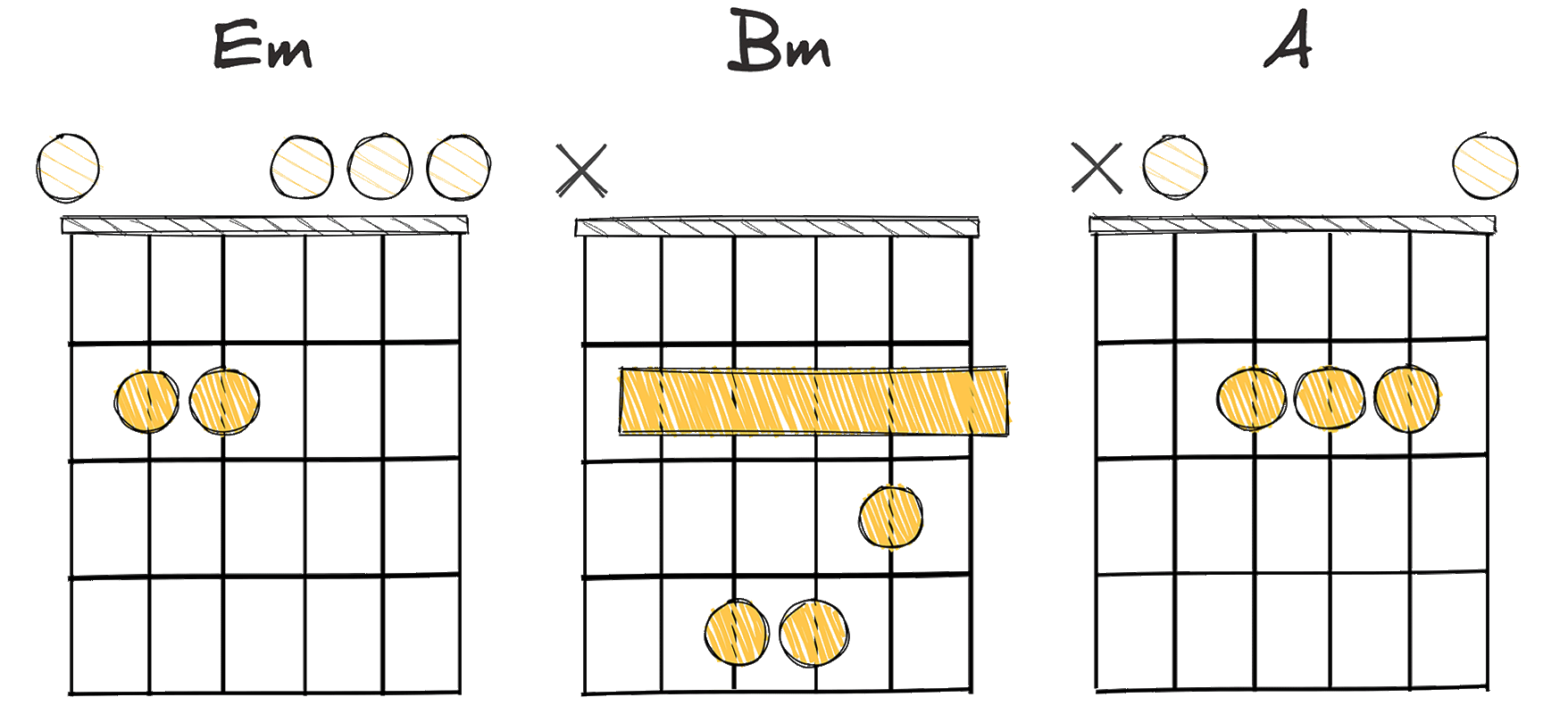
In the study of hip-hop chord progressions, there are commonly used sequences that are admired for their melodic disposition and their ability to convey specific moods.
One of these popular sequences is the ii-vi-V (2-6-5) progression, which has its own unique sound and aura in the realm of hip hop music.
This chord progression, while not as commonly used as some of its counterparts, harnesses a distinct emotional depth and melodious potential that is often awaited in quality hip-hop productions.
The ii-vi-V progression, or Em – Bm – A in the key of D major, is relatively easy to play, making it a favorite choice for many beginners and seasoned professionals alike in the domain of hip-hop.
The simplicity and musical fluidity of the ii-vi-V (2-6-5) progression are largely responsible for its inherent likeability in the genre.
This chord progression delivers a smooth tonal shift that lends itself to the creativity of the artist.
It allows enough space for the artist to play around with the rhythm and melody, personalizing the song to their individual taste and style.
The ii-vi-V progression is featured in several beloved hip-hop songs over the years, subtly contributing to their popularity and appeal among audiences and critics alike.
The historical roots of the ii-vi-V progression can be traced back to classic soul and rhythm and blues music, which had a profound impact on the birth and subsequent evolution of hip-hop.
These older genres shaped the soundscapes of hip-hop, influencing its chord progressions like the ii-vi-V, as much as its lyrical themes and artistic expressions.
In recent years, the use of the ii-vi-V progression has continued to thrive in different sub-genres of hip-hop, suggesting its enduring relevance and flexibility as a musical component.
This progression offers a sort of musical shorthand, conveying complex emotional landscapes with just three simple chords.
The ii-vi-V (2-6-5) chord progression, even in its simplicity, proves to be a powerful tool in hip-hop music, showcasing the genre’s ability to harness traditional musical techniques in innovative and expressive ways.
The Bottom Line
After reviewing various chord progressions, it is apparent that they are the backbone of most music genres, providing a map for where the music will go.
The most popular chord progressions remain I-IV-V and II-V-I due to their harmonic resonance and versatility.
Experimentation with different progressions, such as I-IV-vi-V or ii-VI-V, also offers an opportunity to create a fresh and unique sound within music.
Understanding these progressions allows for a deeper grasp of music, paving the way for enhancing compositions and songwriting skills.
It is intriguing to note how a few simple progressions can yield a wide range of moods and expression in music, proving their fundamental role in creating melodious harmony.
In love with guitars, and gear; expert in all things music! Been writing about guitars for about 5 years and counting. Born in the ’90s. Alma Mater: University of Havana. Always curious, trying to understand the world. #TeamFender




